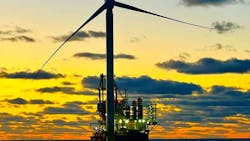Eversource Selling Last Offshore Wind Stakes for $1.1B
The leaders of Eversource Energy have signed a deal to sell the company’s stake in the South Fork Wind and Revolution Wind offshore projects, a move that will complete the Northeastern utility’s exit from the offshore wind sector.
Chairman, President and CEO Joe Nolan and his team expect that the planned sale of Eversource’s 50% holdings in South Fork and Revolution to Global Infrastructure Partners will generate about $1.1 billion in cash for Eversource by the middle of this year. The two companies have agreed to potentially adjust that number as the 132-megawatt South Fork site east of Long Island and the 704-megawatt Revolution project offshore Rhode Island ramp up commercial operations and Eversource will share some of the developments’ remaining construction costs.
“We continue to believe that offshore wind represents the most significant opportunity to decarbonize the electric generation footprint of New England,” Nolan said in a statement Feb. 14. “Eversource will remain an integral player in this historic shift to a clean energy generation mix by focusing on our strengths as a regulated transmission builder and operator.”
New York-based Global Infrastructure Partners manages $100 billion in assets around the world and focuses on the energy, transportation, digital, water and waste sectors. The leaders of the company, which was founded in 2006, last month agreed to sell to BlackRock Inc., the world’s largest asset manager, in a deal valued at more than $12 billion.
Other Recent Notable Offshore Wind News
Jan. 10: Empire Wind 2 Offshore Wind Project Announces Reset, Seeks New Offtake Opportunities
Jan. 3: Avangrid Announces First Power from Vineyard Wind 1
Dec. 8: California Joins Global Offshore Wind Alliance To Build 380 GW Of Offshore Wind Energy By 2030
Nov. 6: Dominion Execs: We’re Close to Signing Offshore Equity Financing Partner
Nolan first announced that the Eversource team was considering getting out of offshore wind in the spring of 2022. Since then, the company has sold to Denmark’s Ørsted A/S its stake in about 175,000 leased acres off the coast of Massachusetts and agreed with Ørsted executives on the sale of its 50% share of the 924-megawatt Sunrise Wind plan offshore New York. (The latter deal is contingent on Sunrise being picked by New York regulators.)
Those transactions have come with a hefty price tag, though, because of the deteriorating economics of the U.S. offshore wind sector in the past several years. After booking a $400 million impairment charge last spring, Eversource took a charge of nearly $1.8 billion in the fourth quarter to cover potential losses and higher project costs at Sunrise and Revolution. At the end of the year, Eversource’s accountants assigned a combined value of just $35 million to the three wind developments.
Eversource’s leaders on Feb. 14 also said they are looking to sell Eversource’s Aquarion water distribution business, which has about 241,000 customers in three states, with Connecticut accounting for more than 90% of that number. The division last year booked a net profit of $33.1 million, down from nearly $37 million in 2022, and has a rate base of about $1.3 billion.
Aquarion has been under Eversource’s umbrella since December 2017, when the company paid nearly $1.7 billion for the business. Nolan and his team now say it “is likely of substantial value to another owner as part of a larger strategic water business or infrastructure platform” and added that a sale also will mean Eversource won’t have to sell as much stock to fund investments in the coming years.
The wind-related charges unsurprisingly dominated Eversource’s fourth-quarter earnings report, which showed a net loss of nearly $1.3 billion. Operating income climbed 7% to $559 million thanks in part to lower purchased power costs. Operating revenues fell to $2.69 billion from $3.03 billion during the quarter.
Investors appeared to like the sound of what Nolan and his team have in mind: Shares of Eversource (Ticker: ES) were up 4% to nearly $57 in midday trading Feb. 14. Over the past six months, however, they are still down about 15%, which has cut the company’s market capitalization to about $20 billion.
About the Author
Geert De Lombaerde
Senior Editor
A native of Belgium, Geert De Lombaerde has more than two decades of business journalism experience and writes about markets and economic trends for Endeavor Business Media publications T&D World, Healthcare Innovation, IndustryWeek, FleetOwner and Oil & Gas Journal. With a degree in journalism from the University of Missouri, he began his reporting career at the Business Courier in Cincinnati and later was managing editor and editor of the Nashville Business Journal. Most recently, he oversaw the online and print products of the Nashville Post and reported primarily on Middle Tennessee’s finance sector as well as many of its publicly traded companies.
